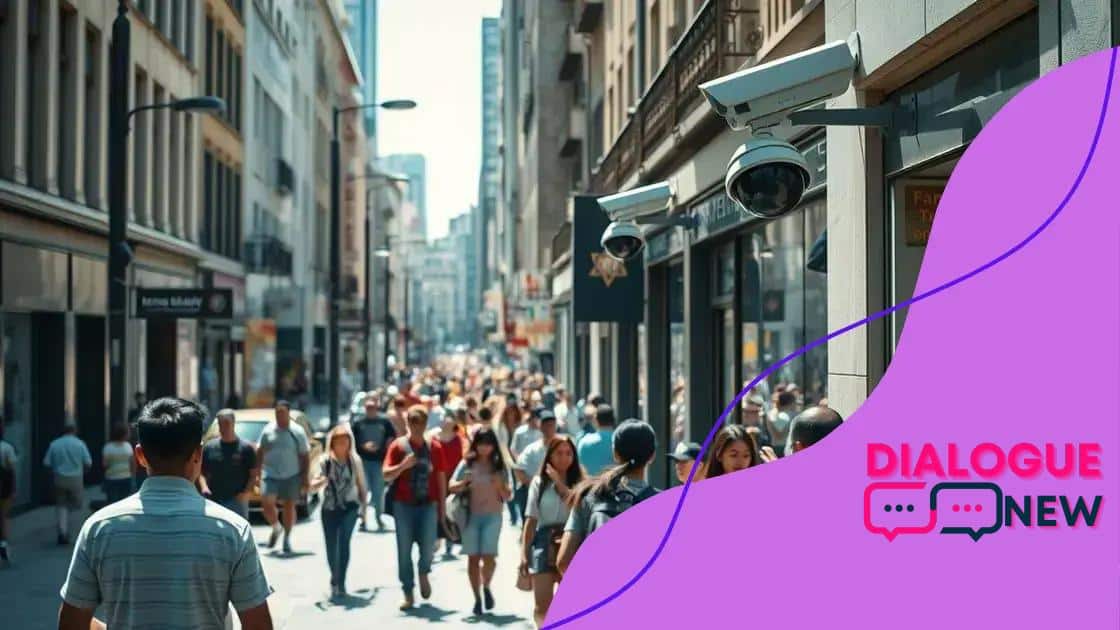The role of facial recognition in enhancing public safety

The role of facial recognition in enhancing public safety includes improving law enforcement efficiency, preventing crime, and streamlining security processes while raising important concerns about privacy and data protection.
The role of facial recognition in enhancing public safety has sparked intense debate. How exactly does it contribute to a safer environment? Let’s delve into its potential and challenges.
Understanding facial recognition technology
Understanding facial recognition technology is vital for grasping its role in modern security systems. This technology works by identifying individuals based on unique facial features. But how does it actually function?
Facial recognition technology uses algorithms to analyze facial structures, capturing key details such as the distance between eyes and the shape of the jawbone. These features create a digital template for each individual, making it easier to match faces in various situations.
How does it work?
The process begins by capturing an image of a face. This image can come from a camera, smartphone, or other devices. Once the image is captured, the technology extracts facial data. This data is then compared to a database of known faces.
Key features of facial recognition technology:
- Data collection: It collects images through surveillance cameras.
- Template creation: Unique identifiers are generated from the analyzed facial features.
- Matching: The template is matched against a database for identification.
- Real-time analysis: It can identify people in live video feeds.
As this technology advances, its accuracy improves, leading to more effective safety measures. In public places, facial recognition can help law enforcement identify suspects faster and enhance overall safety. However, there are important ethical considerations, such as privacy and consent.
In practice, cities around the world are integrating these systems into their safety protocols. For example, airports use facial recognition to streamline identification processes and increase security. With the growing use of this technology, discussions about its implications will continue to evolve.
Ultimately, understanding how facial recognition technology works is essential for recognizing its potential benefits and challenges in public safety.
Benefits of facial recognition for public safety
The benefits of facial recognition for public safety are substantial and varied. This technology can drastically improve the way law enforcement and security agencies operate in urban environments. By leveraging facial recognition, authorities can enhance their ability to identify and apprehend criminals swiftly.
One of the key advantages is the potential for crime prevention. When cameras equipped with facial recognition technology monitor public spaces, they can deter criminal activities. Knowing that they might be recognized and tracked can discourage potential offenders from acting.
Increased identification speed
Facial recognition allows for faster identification of individuals. This speed is essential in emergencies when time is critical. For instance, in a crowded venue, security personnel can quickly scan faces and identify potential threats.
Key benefits of facial recognition:
- Enhanced safety: Real-time monitoring can help authorities respond quickly to incidents.
- Efficient investigations: It assists officers in solving crimes by providing leads through facial matches.
- Streamlined processes: Law enforcement can handle cases more efficiently with this technology.
- Public reassurance: Knowing that facial recognition is in use can provide a sense of security for community members.
Additionally, this technology is crucial for identifying missing persons and locating individuals with outstanding warrants. It serves as a powerful tool in the arsenal of law enforcement agencies.
While there are notable advantages, it is important to address privacy concerns. The uses of facial recognition must be balanced with safeguarding individual rights. Clear regulations and guidelines are necessary to ensure ethical use and public trust.
By understanding the benefits, communities can engage in meaningful conversations about integrating facial recognition into public safety strategies while ensuring respect for civil liberties.
Challenges and concerns surrounding facial recognition

While there are many advantages to using facial recognition technology, there are also significant challenges and concerns that must be considered. These issues can impact its implementation and acceptance in society. Understanding these concerns is important for developing ethical guidelines.
One major challenge is the accuracy of the technology. Facial recognition systems can sometimes misidentify individuals, leading to false positives. This can result in wrongful accusations or detentions, causing serious harm to innocent people.
Common concerns include:
- Privacy rights: Many worry that constant surveillance infringes on personal privacy.
- Data security: Personal data could be at risk if the systems are hacked.
- Bias and discrimination: Studies have shown that some systems perform poorly on people of certain races or genders, leading to unequal treatment.
- Lack of regulation: There are currently few laws specifically governing how facial recognition technology can be used.
In addition to these challenges, public perception also plays a crucial role. Many people feel uneasy about being constantly monitored, even if the intention is to enhance safety. This discomfort can lead to protests against its use in public spaces.
Moreover, ethical questions arise around consent. If individuals are not informed about facial recognition usage, it raises concerns over their ability to give consent. Asking for consent in crowded environments becomes impractical, which complicates the ethical landscape.
As technology evolves, the conversation about these challenges and concerns will continue to grow. It’s essential for stakeholders, including governments and technology companies, to work together to address these issues. Finding a balance between security and privacy will be key in shaping the future of facial recognition technology.
Real-world examples of facial recognition applications
Facial recognition technology is being used in various real-world applications, showcasing its effectiveness and versatility. Companies and governments around the world are adopting this technology to enhance security, streamline operations, and improve services. Understanding these practical implementations helps highlight the benefits and challenges of facial recognition systems.
In airports, facial recognition systems are increasingly used to speed up the check-in and security processes. Passengers can simply scan their faces at kiosks, which verifies their identity without the need for boarding passes or identification cards. This not only saves time but also enhances security measures by ensuring that only authorized individuals access specific areas.
Key applications of facial recognition technology:
- Law enforcement: Police departments use facial recognition to identify suspects in crime investigations, helping to solve cases more efficiently.
- Retail security: Stores employ this technology to prevent theft and fraud by identifying known shoplifters as they enter.
- Banking services: Financial institutions use facial recognition for secure customer authentication, allowing access to accounts via facial scans instead of traditional methods.
- Smartphones and devices: Many smartphones utilize facial recognition for unlocking devices, providing a convenient and secure alternative to passwords.
Another impactful use is in events and large gatherings. Organizers use facial recognition to expedite entry and enhance security measures, enabling a smoother experience for attendees. This technology can alert security to potential threats by identifying individuals with negative past interactions.
Moreover, cities like London and New York have implemented facial recognition systems in public spaces to improve overall safety. Surveillance cameras equipped with this technology can monitor crowds and identify individuals on watchlists, helping authorities respond to potential threats more proactively.
Despite these advantages, concerns about privacy and data protection remain. It’s crucial for organizations implementing facial recognition to consider ethical practices and obtain proper consent where needed. Balancing effective use with respect for individual rights is essential for the responsible deployment of this technology.
Future trends in facial recognition and security
The future of facial recognition technology is promising and filled with exciting trends that could reshape security systems globally. As technology advances, new innovations are set to emerge, enhancing the efficiency and effectiveness of safety measures. Understanding these trends is crucial for both consumers and businesses alike.
One major trend is the integration of artificial intelligence (AI) with facial recognition systems. This combination will allow for more sophisticated analysis and real-time data processing. With AI, facial recognition systems can learn and improve over time, adapting to various environments and conditions.
Emerging trends in facial recognition technology:
- Increased accuracy: Future advancements will focus on improving the accuracy of matches and reducing false positives, making the technology more reliable.
- Mobile integration: More applications will integrate facial recognition into mobile devices, allowing users to unlock phones, access accounts, and enhance security on the go.
- Privacy-focused solutions: As concerns about privacy grow, developers will work on creating systems that prioritize user consent and data protection.
- Cross-platform usage: Facial recognition is expected to be increasingly adopted across different industries, from finance to healthcare, enhancing security protocols universally.
Moreover, the use of facial recognition technology is projected to expand beyond surveillance. For example, businesses may leverage it for personalized customer experiences, such as customizing services based on individual preferences detected through facial analysis.
As cities continue to evolve into smart cities, facial recognition will play a key role in urban planning and public safety. Smart traffic systems can utilize facial recognition to manage flows and enhance security in crowded areas.
However, alongside these advancements, ongoing discussions about ethics and policy will become more important. Public opinion and government regulations will shape how facial recognition is deployed and monitored. Finding a balance between innovation and privacy rights will be essential to the successful adoption of this technology.
Facial recognition technology offers remarkable benefits for enhancing public safety, yet it also raises important concerns. As we look ahead, it is vital to balance the advantages of security with the need for privacy. Embracing future advancements in this field can lead to smarter cities and safer communities, provided we navigate ethical challenges carefully. By understanding these dynamics, we can leverage facial recognition technology responsibly, ensuring it serves to protect and empower society.
FAQ – Frequently Asked Questions about Facial Recognition Technology
What are the main benefits of facial recognition technology?
Facial recognition technology enhances security, improves law enforcement efficiency, and streamlines processes in public spaces.
What challenges does facial recognition technology face?
It faces challenges related to accuracy, privacy concerns, bias, and lack of regulation.
How is facial recognition technology used in everyday life?
It’s used in areas like airports for faster check-ins, retail for security, and on smartphones for secure access.
What does the future hold for facial recognition technology?
The future may involve better accuracy, AI integration, and more privacy-focused systems, balancing security with ethical considerations.





